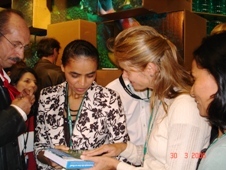
To avert the current biodiversity crisis, we must renew our relationship with nature. Changes in attitudes and approaches are needed at all scales, from the local to the global. Constituencies that recognise the importance of biodiversity for livelihoods and wellbeing, as well as its intrinsic worth, must be built among individuals, communities, corporations and nation states. Working together, they can achieve the challenging but necessary transformation in current patterns of production and consumption.
Action on the ground can be achieved through empowering local communities View case study list
View case study list
Within many local communities there are groups and individuals that care for the environment around them and promote the sustainable use of resources. They may be motivated by the livelihood they derive from a place, by their spiritual or cultural connections to it, or by the value they place on it for recreation. In Turkey, conservationists have been able to raise awareness about wetland conservation and sustainable water use throughout a community by aligning with respected local religious leaders (![]() ). Conservation organisations can play an important role by providing support and coordination to these local champions for conservation, helping them to influence decisions at local and national levels (
). Conservation organisations can play an important role by providing support and coordination to these local champions for conservation, helping them to influence decisions at local and national levels (![]() ). In the BirdLife context, a key element in this has been the emergence of a diverse network of ‘Important Bird Area Local Conservation Groups’, which have in common an association and commitment to safeguarding the biodiversity of a particular place. Often these groups, known regionally as Site Support Groups and Important Bird Area Caretakers, are networked at national level. Their activities may include site monitoring, local advocacy, education and awareness, and development of livelihoods linked to biodiversity conservation (
). In the BirdLife context, a key element in this has been the emergence of a diverse network of ‘Important Bird Area Local Conservation Groups’, which have in common an association and commitment to safeguarding the biodiversity of a particular place. Often these groups, known regionally as Site Support Groups and Important Bird Area Caretakers, are networked at national level. Their activities may include site monitoring, local advocacy, education and awareness, and development of livelihoods linked to biodiversity conservation (![]() ,
, ![]() ,
, ![]() ,
, ![]() ,
, ![]() ,
, ![]() ).
).
The BirdLife Partnership is a shared force for action, yet is responsive to national situations View case study list
View case study list
BirdLife is an example of how global and local conservation concerns can be linked. It is a worldwide alliance of conservation organisations that share the same mission and work together combining actions at local, national and international levels. With around 2.5 million members and 10 million supporters worldwide, the network of over 100 national organisations operates in a wide range of situations dealing with many issues—from local communities helping to protect specific sites to coordinated work on global conventions (![]() ,
, ![]() ,
, ![]() ) and public campaigns to promote debate and challenge actions that threaten biodiversity (
) and public campaigns to promote debate and challenge actions that threaten biodiversity (![]() ,
, ![]() ,
, ![]() ).
).
Strategic partnerships with industry can help to achieve common business and biodiversity objectives View case study list
View case study list
The corporate sector has an enormous impact on the global environment. This is particularly true of those businesses that deal directly with natural resources, whether through agriculture, forestry or extraction of minerals or fossil fuels. BirdLife and other organisations are increasingly engaging with these to promote greater awareness of biodiversity and to help businesses recognise that caring for it can have a range of benefits, including increased planning and operational efficiency, management of essential ecosystem services, and development of best practices that help improve their public standing. To do this BirdLife and others are entering into strategic partnerships with industry that help businesses minimise their negative impacts while responding to positive opportunities for globally-significant conservation action to be undertaken locally (![]() ). These can help companies secure their ‘licence to operate’, and enable them to engage with concept of sustainable development, while also providing collaborative support to BirdLife and other organisations for much needed conservation action on the ground.
). These can help companies secure their ‘licence to operate’, and enable them to engage with concept of sustainable development, while also providing collaborative support to BirdLife and other organisations for much needed conservation action on the ground.
Effective conservation outcomes depend on good Government-NGO relationships View case study list
View case study list
Throughout the conservation and development community, effective outcomes depend on good relationships between governments and non-governmental organisations. Organisations such as BirdLife need to be committed to working closely with government at all levels. BirdLife Partners work with a range of government ministries around the world, particularly those concerned with development (![]() ), planning, environment, tourism, and specialist agencies such as protected area and wildlife departments that play a key role in environmental governance and biodiversity conservation. The Partnership has been catalytic in creating a range of consultative forums at national level, including so-called National Liaison Committees (
), planning, environment, tourism, and specialist agencies such as protected area and wildlife departments that play a key role in environmental governance and biodiversity conservation. The Partnership has been catalytic in creating a range of consultative forums at national level, including so-called National Liaison Committees (![]() ), and forms temporary and permanent working relationships with complementary NGOs, such as coalitions of environmental lawyers or journalists, to advance short and long term relationships.
), and forms temporary and permanent working relationships with complementary NGOs, such as coalitions of environmental lawyers or journalists, to advance short and long term relationships.